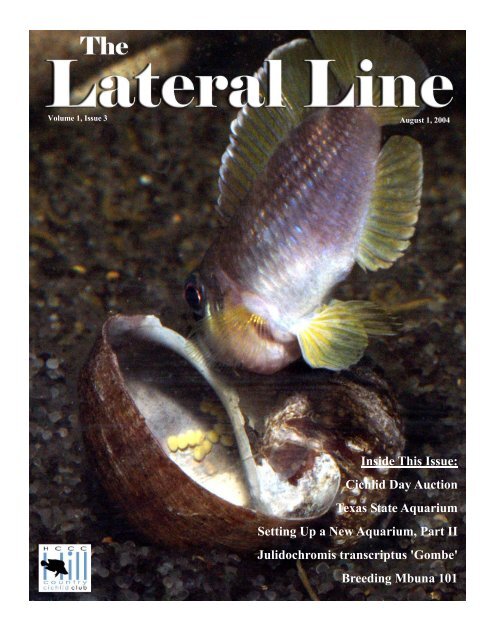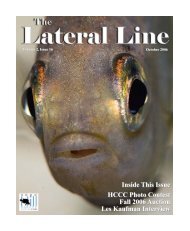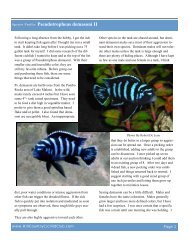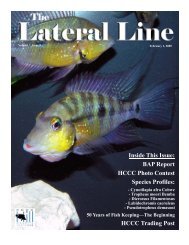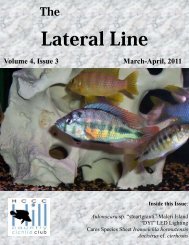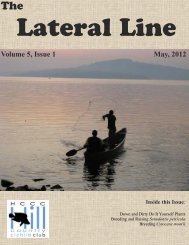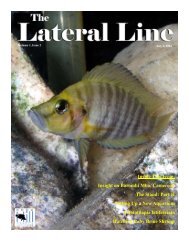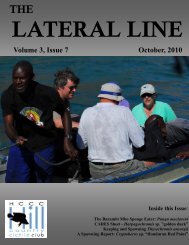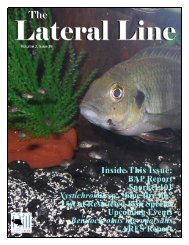Lateral Line August 2004-1.pub - Hill Country Cichlid Club
Lateral Line August 2004-1.pub - Hill Country Cichlid Club
Lateral Line August 2004-1.pub - Hill Country Cichlid Club
- No tags were found...
Create successful ePaper yourself
Turn your PDF publications into a flip-book with our unique Google optimized e-Paper software.
Volume 1, Issue 3 <strong>August</strong> 1, <strong>2004</strong>Inside This Issue:<strong>Cichlid</strong> Day AuctionTexas State AquariumSetting Up a New Aquarium, Part IIJulidochromis transcriptus 'Gombe'Breeding Mbuna 101
<strong>August</strong> 1, <strong>2004</strong>INSIDE THIS ISSUE:Texas State Aquarium 3New Aquariums Tips 9Species Profile 11Breeding Mbuna 101 12Friends of the HCCC 14Available BAP Fry 14Auction Flyer 15Upcoming Events:• <strong>August</strong> Meeting TBA, visitour website for more Information.• <strong>Cichlid</strong> Day <strong>2004</strong> AuctionOctober 23rd,BAP ReportJuly has seen some changes to the standings. Dave hassurged up with our first Cynotilapia afra spawn andwe’ve had the first three entries from a new member,Blair. He has spawned our club’s first Cyprichromis leptosomaand Lethrinops marginatus.New members will probably be the driving force for ourBAP as older members run out of point earning spawns.Lets keep those fish healthy and spawning and don’t forgetto submit your BAP reports to earn your points.Don’t forget, HCCC members can purchase BAP offspringat unbelievable prices.<strong>Cichlid</strong> Day <strong>2004</strong> AuctionThe <strong>Hill</strong> <strong>Country</strong> <strong>Cichlid</strong> <strong>Club</strong> is proudto announce that a date has been set forour first special event. The auction willbe held on Saturday, October 23rd at12:00 P.M. Everyone is welcome to participate.Hobbyists and professionalswill be bringing fish and other items.Non-members are welcome.A couple weeks ago, the Bracken UnitedMethodist Church Fellowship Hall inPicture of the MonthCurrent StandingsGreg 270Charles 110Duc 95Dave 90Robert 85Paul 85Lisa 60Blair 55Brian 40Christina 25San Antonio was rented with funds generatedfrom yearly dues and BAP fishdonations. All monies generated fromthe auction will go to fund larger upcomingevents in which we hope to haveguest speakers, fish shows and more auctions.For more information about the <strong>Cichlid</strong>Day Auction, see page 15 of this newsletteror visit www.xdeleon.com/hcccCover Photo:Lamprologusocellatus guardingeggs.by Spencer JackPictured above is a Haplochromis sp. 35.
The <strong>Lateral</strong> <strong>Line</strong>Texas State AquariumWouldn't it be great if there were a huge public aquarium dedicatedentirely to cichlids? Unfortunately, there's not one, but there is awonderful marine aquarium just a few hours' drive from San Antoniothat lends itself to the cichlid enthusiast's vivid imagination...Page 3— by Lee Ann Steevesarea behind it that contained several youngsharks, rays and a flounder.Of course, the first thing I thought of was,"Wow! This would make a GREAT tank forEnantiopus melanogenys!" Yes, I know they'renot brackish fish, but the tank... it's sooo perfect!On the wall opposite this display was a tankwith reptiles in it... alligator babies, turtles...stuff you really don't want to feed your fingersto. The water looked dark, and the tank wastall... so naturally I was thinking Angels - altumperhaps.Next we came to this shallow star-shaped poolthat had sea urchins, hermit crabs and sailfinmollies in it. This was sort of a petting area.The Texas State Aquarium in Corpus Christi,Texas. I took my vacation this week, and decidedto treat Greg and Karli to their first ever trip tothe beautiful South Coast. The Aquarium was theultimate destination, of course...that beach thingis naturally just something you do to kill timeright?Anyway, we couldn't help but picture our cichlidsin those huge tanks... I don't think we passed byone tank that we didn't say something like,"wow... can you imagine filling this thing up withmbuna?" Actually, I think what Greg kept saying was "Victorians",but since I'm the one writing this thing, it gets to be my favoritefish, right?As we entered the first room, we were greeted by a large, shallowhabitat containing estruarian species. On the end facing the entranceto the room were fish found in a 'common zone' betweenfresh and salt water. Behind this area was a 'land' area that housedshore birds found in the same area, including a duck that found itvery difficult to navigate the sandy bank toward the shallow, sandyYears ago there were small starfish in thispool, but I suspect they found that they didn'tlike being handled all that much. After turninga few urchins over to see what they were madeof, I envisioned taking them out and puttingshell-dwellers in this tank, such as Neolamprologuscalliurus. I know shellers hang out indeeper water than this, but still... my imagina-(Continued on page 4)
The <strong>Lateral</strong> <strong>Line</strong>Page 4tion ran away with me, and I decided it would also lookgreat with some goby cichlids like Eretmodus, or evensome of the smaller flashy cichlids like Hemichromis.In the rooms that followed these, there were severalsmaller tanks. One in particular caught my eye. It houseda couple of horseshoe crabs, some flounders, a batfish(yes, that's what it's called - I expected to see that longangelfish looking thingie, but this looks more like a bat onthe ground), and some sea horses. I thought rams wouldbe awfully cute in this tank. Greg kept stepping on my toewhen I said things like that, so by now I was learning tojust take pictures and keep my mouth shut like a goodlittle tourist.Next came a good-sized tank with lots of rock work in thebackground. It was as tall as the wall and a good 6-8 feetwide. I thought this would make an excellent mbuna tank,given enough turbulence, light and algae. Greg thought itwould bettersuit some nyererei.Instead, ithoused a lot ofmarine life...sergeant majors,angelsand butterflyfish to name a few.There was a dome-shaped tank that was kind of interestingtoo. It housed some smaller non-vertibrate lifeforms including this peppermint shrimp and the scallop,who sat there right in front of the tank wall withhis shell wide open showing off every one of his 32blue eyes. This would have been a great Julidochromistank by the way. Just thought I'd mention it.Then there was a huge column tank in the middle ofthe room that looked like it would be a great place tokeep some of the deeper open-water fish like Cyphotilapiafrontosa or Benthochromis tricoti. Ofcourse it would look totally awesome with a hugeschool of Cyprichromis spiraling up and down.Snapping out of it though, I saw that it did indeedhouse schooling fish. Most of the fish in this tankwere silver... I have no idea what they were exactly,but it was a stunning display. It was very difficult toget good pictures from these tanks though, becauseof the refraction from the curved sides.One of the many aquariums included a small reeftank pictured below. I'm sorry, but it's just so beauti-(Continued on page 5)
The <strong>Lateral</strong> <strong>Line</strong>Page 5ful that even my imagination couldn'tpicture replacing this with cichlids. Everythingwas thriving (no damsels in distresshere)... perfect just the way it is!On the adjacent wall was a very smalltank (maybe a foot by a foot). If youlook carefully near the base of the plants,you will see pipefish. See that shell inthe background? Yep... I'm thinkingocellatus too!Another nearby tank showed the differentcritters that live in floating sargassum.You know that seaweed that sometimeswashes up on shore? Yep, that'sthe stuff. It floats around in the gulfstream, and lots of critters make it home,including tiny baby sea turtles! Anyway,some of the fish that have evolved to livehere have developed special fins thathelp camouflage it... like this angelfishlookingthing. It's not a very good picture,but I really wanted to illustrate whatI meant. As you can see in the picture,one of the other fish has developedmarkings to help it hide in the sargassumas well.Yet another tank with sergeant-majors,angels and butterflies... yet another tankthat spawned wild visions of large cichlidsliving in large groups... perhaps hugeflocks of Aulonocara, Copadichromis orProtomelas! This particular fish was ofstriking beauty. It isa rock beauty angelfish(Holocanthustricolor). Apparentlythis fish is difficult tokeep in captivity, butthe specimen we sawseemed quite spunky.Next we get to theBIG BIG BIG fish. Ithink the display is called "Islands ofSteel". This tank is really really reallyhuge. The big catches live in there....sharks, sea turtles, groupers, humpbackwhales (just kidding!)... It basicallyshows what lives under and around thebig oil rigs out in the gulf... these bigsteel structures have become a reef of(Continued on page 6)
The <strong>Lateral</strong> <strong>Line</strong> Page 6sorts - something for clingy-life to hangonto and other life to feed on which biggerother life feeds on, etc etc... basicallycreating a veritable cafeteria for the bigguys. Wouldn't that be a great tank forBoulengerochromis microlepis? Or, ifyou're a smart-alec like Greg, you mightwant to put a single pair of Neolamprologusmultifasciatus in there.Next we came to a room apparentlygeared toward kids. Lots of Nemo-esquedisplays in there, including this tank thathouses a blue tang (Dory ... she speakswhale, you know!). It also is home to acouple of lion (king?) fish and an interestingzebra-striped eel that insisted onhanging out UNDER the grass in thebottom of the tank. He was gone before Icould get the camera focused... whichwas really hard since the tank itself wasone of those columnar ones. Lessonlearned... flat glass is your friend if youwant to take fish pictures! Since we lovetaking fish pictures, I just couldn't imagineputting cichlids in this tank. I was sofrustrated by it that I handed the cameraover to Greg... the master!Of course, no lion-fish tank would becomplete without a giraffe.There was even a HarryPotter themed tank. It hadlarge castle-like structures,and a statue of Hagrid, andif you looked very carefullyfor movement, thesebig boulders in the backgroundappeared to bebreathing... and they hadeyes... I still don't knowwhat they were, but I'massuming they were some kind of stonefish.I tried to get pictures but becausethe Aquarium requested that no flash beused on some of the tanks, I had to do itwithout the flash and they came outreally fuzzy. I can't see decorating acichlid tank with Harry Potter things, butI could see putting some Steatocranus inthere. I don't know what made me thinkof those. Maybe it was the round headand still nature of the fish that lived inthere.The tank next to it was home to threefrogfish. Like their name implies, thesefish look a lot like frogs, and they sitthere ... well... like frogs. It took a fewseconds before I saw them at all becausethey were sitting so still. Bizarre lookingcreatures, these ambush predators are inthe same group as anglerfish, and onesmall species of frogfish, the Sargassumfish (Histrio histrio) lives in the sargassumweed and actually has prehensilefins to help it move through the weed insearch of food.Another tank housed a huge pacific octopushiding behind some buried treasurethat wasn't buried. There were also somepretty cool starfish in that tank. Yet anotherhad some really large spiny lob-(Continued on page 7)
The <strong>Lateral</strong> <strong>Line</strong> Page 7sters in it. These lobsters are different from Mainelobsters... they don't' have the huge front claws.Speaking of lobsters, they have a really cool blueone that has been on TV. His tank was decoratedin spilled paint. According to the plaque by thetank, this is a natural but rare color morph thatoccurs with the normally-colored lobsters. If youcook it, it still turns red. Weird, eh? I don't thinkthis one will be testing that theory though.Next we came to the 'Flower Gardens'.The Flower Gardens is a coral reef about300 miles east of Houston, and about 60feet straight down. The reason it's calledthe Flower Gardens is because Spanishexplorers looked straight down into thewater and saw so much color that it lookedlike a sunken flower garden to them. Thecorals grew onto salt domes that billowedup from the bottom of the gulf. The reef isrelatively small and definitely isolated,and very well protected... by law anyway.I read somewhere that below the coralsthemselves there is a place where the saltstill spews out a little and has created abrine lake about 210 feet wide and about10 inches deep. There are some bacteriathat thrive in this environment, and somefish have developed the ability to take short dives into thissalty wash to take advantage of this food source. Anyway, theAquarium has re-created part of the Flower Gardens in the onebig tank, and we got to see the presentation given at feedingtime. It's really an interesting presentation, and I recommendthat you catch it if you can. There is a ray in the tank that is'bottle trained'... he takes his krill from the plasticbottle in the diver's hands... just sucks it out like ababy... it's really funny. The girl that gave thepresentation also gave some useful information tothose of us that like to go wading in the gulf...how to not get stung by a sting-ray. Basically,you don't want to 'walk' like you do on land... youwant to shuffle your feet as you go along. Thiswarns them to get out of the way and you're notnearly as likely to step on them as you might otherwisebe. Oh, I almost forgot... this tank? Tropheus!What else?Between this room and the out door, there is aroom with several jellyfish tanks. Obviously wecouldn't' take pictures, but it was worth seeing.Some of them are bioluminescent and watchingtheir iridescent colors ripple along their insides is mesmerizing.Did you know there is a type of freshwater jellyfish that livesin Lake Tanganyika in Africa? Wouldn't it be interesting to getthose into our tanks with our cichlids? I bet they would be very(Continued on page 8)
The <strong>Lateral</strong> <strong>Line</strong>hard to keep. Still... I wonder where they keep the peanut butterfish??Next we went outside to see the dolphins. This one in particularwas going through the ropes. I'm not sure who was beingtrained... the dolphin or the human in the white shirt. She surelooked like she was having fun, though.Karli had some close encounterswith the sea turtles. If you lookclosely, they have big blackeyes... they do look a little alienlikedon't they? Apparentlythese turtles (I think this onemay be a Ridley) are endangered,and the Aquarium has taken several inthat have been too injured to make it in the wild(some of them are missing flippers, for example).Our final stop at the Aquarium was at the birdand reptile exhibit. Karli got to hold (well,touch) a baby alligator! It really made her day.The bird part of this exhibit consisted of severalbirds of prey that had been too injured to returnto the wild. I think it's great that this 'zoo' isgiving these animals a new lease on life.Page 8(Continued on page 9)Downstairs from the dolphin exhibit were several more exhibits,including a petting area with rays and small sharks, a seaotterhabitat, a sea-turtle habitat and a bird and reptile display.The pet-a-ray tank was really cool (they had removed thestingers of course)... sting rays feel a lot like jello on their topside.For some reason the Aquarium insists that you only petthem with two fingers. I don't know what that reason is, but itmakes you wonder if they're trained to attack if you touchthem with three? We found an egg case in that pool. Peoplearound us had no idea what itwas, and it's probably just aswell. We tossed it toward theback of the pool where peoplecouldn't reach, just in case theAquarium people wanted to salvageit.
The <strong>Lateral</strong> <strong>Line</strong> Page 9All in all, the trip to the Texas StateAquarium was fantastic. I highly recommendit to anyone. Even thoughit's not full of cichlids, as you cansee, you can still pretend it is. Maybesomeday someone will build a cichlidzoo. In the meantime... keepdreaming!Now... let's hit that beach!(All photos courtesy of the Steevesfamily).Tips for Setting Up Your New Aquarium: Part II— by Bob NuckolsOriginally appeared in FAMA March <strong>2004</strong>.Reprinted with permission from author.[In the July issue of the <strong>Lateral</strong> <strong>Line</strong>, varioustopics were covered including location, preparingyour new aquarium, types of filtrationand biological media]Time for the decorations. Add the rocks,driftwood, action ornaments, and plantsto decorate the aquarium. Whether yourtank is natural or not, remember to leavesome open areas in the front of theaquarium for the fish to swim. Take yourtime and try to imagine how you wantyour aquarium to look and how to makethe decorations look their best. Try not tomove the decorations after the fish are inthe aquarium because this can stress thefish.Now that the water and decorations arein the aquarium, you must make sure thatthe water is safe to add the fish. Thatmeans adding some type of water conditioner.The purpose of this is to removechlorine, chloramine, ammonia and otherharmful chemicals. Ask the pet store personnelfor advice on which productworks best with your local water.The aquarium is filled, decorated, andthe water is conditioned - time to add thefish, right? Well, not quite. The waterneeds to be the correct temperature forthe fish you are going to keep. For goldfish,room temperature is fine but fortropical fish you will need a heater. Formost of us a heater of five watts per gallonis fine. And most tropical fish preferthe temperature to be between 75-80 degreesF. To see what the temperature is,be sure to buy a thermometer and put itwhere you can see it. Check the temperatureevery day because heaters can anddo fail. Always check the heater beforeusing it for cracks or flaws, you certainlydon't want you or your fish to getshocked. Also don't leave the heater(Continued on page 10)“Whether your tankis natural or not,remember to leavesome open areas inthe front of theaquarium for the fishto swim.”
The <strong>Lateral</strong> <strong>Line</strong>plugged in if it is out of the water - it canoverheat and break; or if it just gets hotand is put back into the aquarium, it canbreak. So be careful.Lighting is nice to have on your aquarium.Besides allowing you to see yourfish better, a light hood will also reduceevaporation and keep the fish fromjumping out. Cut out the back strip tomake room for the heater, filter, etc.Fluorescent hoods are the best becausethey use less energy, produce little heat,the bulbs last longer and they provide amore even light. A simple on/off timercan be used to light the aquarium foreight to ten hours a day. Avoid too muchlight as that could lead to algae blooms.Now, are we ready to add the fish? Notquite yet, it is important to test your waterbefore you add the fish for unacceptablelevels of ammonia, nitrite and pH.There are many ways of controllingthese levels; a good test kit will help youmonitor them. Remember, it will takeseveral weeks to establish the bacteriayou will need. A test kit will help youdecide when it is safe to add the "good"fish.Okay, time to add the fish. Try a few fishto make sure your aquarium is set upright. Float the fish in the bag for ten tofifteen minutes before opening the bagand adding a little of the aquarium water.Add some water every fifteen minutes,after about an hour look at the fish. Arethey doing fine? They should be swimmingaround looking for a way out of thebag. If they are looking good, releasethem into the tank but don't add the waterfrom the bag. If they don't look ready,take a little longer to acclimate them toyour tank.The fish of course will need to be fed. Ifeed my fish only once a day but somepeople feed their fish more often. Justmake sure they eat all the food that isgiven to them. If they don't finish all thefood in five minutes, look for problems.If they are all well, feed less next timeand you can judge how much food thefish really need.Lastly, enjoy the aquarium! Fish can beboth fun and educational. Watching thefish can be stress relieving, so relax andenjoy them. You should be concernedabout the fish but don't let it drive younuts if all is not going well. Use commonsense, take your time and it will all workout. Remember this is supposed to befun.Happy fishkeeping!Page 10“...it is important totest your water beforeyou add the fish forunacceptable levels ofammonia, nitrite andpH.”Julidochromis transcriptus 'Gombe'I acquired my initial group of seven Julidochromistranscriptus 'Gombe' from aseller off of aquabid.com back in 2000.The colony is still going strong till thisday. These are the first Julie-type thatI've kept. I just wanted to write a briefsummary of my experiences with thesewonderful fish.(Continued on page 11)— by Duc Nguyen
The <strong>Lateral</strong> <strong>Line</strong> Page 11When I got my group, they were stilljuveniles; they were about 1.5 - 2 inchesin length. I had them in a 10 gallon tankwith no substrate and no other tankmates. It was loaded with caves for themto hide in. Afterabout 6 months orso, I started tonotice that therewas a pair thatkept hanging outtogether in a terracotta cave but Ididn't take toomuch notice ofthem. I started toobserve that thispair continuouslychased off theother fish in thetank. At the time, I had no other largertanks for them so I gave Greg and LeeAnn Steeves four of my fish; keepingthree of my own. After removing thefish, the aggression level was much better.After about another three months, Imoved into my apartment and broughtthese guys with me. This time, I housedthem in a 20 long with a sandy substrateand lined with a lot of caves for them. Ialso used a sponge filter. At first, it tooka while for them to get acclimated; thepair bond still existed between the originalpair. After about a month, I noticedthat there were these teeny tiny fish thatwere scaling against the cave. I got veryexcited since I've never seen these guysspawn before. The parents just let themswim wherever they wanted to. Theygrew out very slowly. Unfortunately, Imoved again from my apartment to mycurrent home so I had to move themagain after six months in the apartment. Idid my best to keep the tank the same,but that's just impossible. I was not ableto save any of the fry from the Julies.When moving the tank, the pair bondstill remained and they were alreadyback to spawning in no time.Till this day, I still have the original parents.There's a definite size differencebetween the male and female. There'sthe smaller of the two, which got about 3inches (I'm assuming this is the male),and then there's the larger one which isabout 4.5 inches (I'm assuming this is thefemale). The larger of the two keptwatch over the cave where the other onejust kind of hangs out. I think these fishare extremely interesting in looks and inbehavior. Notoriously, Julies tend to bepretty aggressive, but mine weren't toobad. For example, the pair that's in thetank now tolerates the spare male. Hejust doesn't swim over to their end of thetank. I feed mine Tetramin <strong>Cichlid</strong>flakes. I also feed them occasional babybrine shrimp and spirulina flakes.Overall, I would highly recommend theJulidochromis transcriptus. They're anextremely attractive fish and a great additionto anyone's <strong>Cichlid</strong> collection.“When moving thetank, the pair bondstill remained andthey were alreadyback to spawning inno time.”
The <strong>Lateral</strong> <strong>Line</strong> Page 13A note about egg-spots: while the use ofegg-spots specifically for "deception" isnot fully accepted by science it is supportedby anecdotal observation. However,their use or even presence is notcrucial to successful spawning. Manyspecies and individual males have noegg-spots at all, yet still reproduce. Conversely,many females do have eggspots. Female egg-spots are supposed tolack the transparent ring around the yellowcenter. I have found it very difficultto see the difference. Does this suggestthat the movement alone of the anal finis important and adequate for successfulspawning?About half way through a turn (around 3seconds?) they quickly reverse roles withthe male assuming the "I" formation andnibbling at the female's anal fin, morespecifically her papilla, which is locatedjust in front of her anal fin. The alternatingturning/nibbling may continue offand on for minutes or even days beforethe first real eggs appear. There are lotsof "practice runs" and lots of breaks.Often they are interrupted by opportunistictank-mates hoping to steal a deliciousegg. The male occasionally excuseshimself to chase and bit spectators.Eventually the female is stimulated intodropping eggs. Normally one to fiveeggs are dropped at each turn. The femalequickly snatches them up at thecompletion of her "turn" on her way toassuming the "I" position for his "turn".At that moment, the male releases miltfrom his vent, located just in front of hisanal fin. It is fanned by the vibrating ofthe anal fin directly toward and into thefemale's nibbling mouth. As it is ingested,the eggs are fertilized.So maybe you missed all the pageantry,but while feeding, you notice a femalethat eagerly swims up with the grouponly to stare at the food then quickly retreatsback down to the rocks to pacenervously. Maybe she makes a secondtrip up to inspect, and then rejects thefood. Maybe she even makes a third tripand gently eases a tine piece of food intoher mouth, without opening it all theway, then panics and retreats again.Maybe she looks like she already has amouthful of food and occasionally"chews" it. These are all pretty goodsigns she is brooding or "holding".What next? As ethical hobbyists weshould strive to do what is best for Monand kids. For the first approximatelyfour days she holds eggs. Then, providingthey are fertile, the eggs develop tinyheads and tails. While Mon broods shewill eat very little or no food at all.Some evidence suggests that the fry eatsome of the food if she does ingest any.At around 18 days (species and individualspecific) she will begin shopping fora "safe" place to release her freeswimming,fully developed, but miniaturefry. If she cannot find a "safe"place, she may delay releasing longerFemale Maylandia estheraewith mouth full of eggs.
The <strong>Lateral</strong> <strong>Line</strong> Page 14than is healthy for her. The tank shespawned in is probably not "safe". Oncerelease, parental care pretty much ends.The fry are not safe, even from Mon, andDad hasn't been any help since donatingmilt.What can be done to maintain Mon'shealth and help ensure the survival of, atleast, some of the fry? I am aware offour methods that are commonly employedand will discuss them in agonizingdetail next month.Friends of the HCCCVarious businesses have pledged their support to the HCCC. Some offer discounts toclub members while others make their facilities available for meetings and otherevents. Their contributions are greatly appreciated and add an additional benefit toclub members. Links to these organizations can be found atwww.xdeleon.com/hccc/links.php . They include:Available BAP FishThe following species are currentlyavailable to HCCC members only.—Haplochromis sp. Flameback—Lethrinops marginatus—Neolamprologus olivaceous—Neolamprologus falcicula—Lepidiolamprologus hecqui—Neolamprologus multifasciatus—Haplochromis sp. "44"—Pelvichromis pulcher—Astatotilapia latifasciata
The <strong>Lateral</strong> <strong>Line</strong> Page 15HCCC <strong>Cichlid</strong> DayFish AuctionThe <strong>Hill</strong> <strong>Country</strong> <strong>Cichlid</strong> <strong>Club</strong> would like to invite fish enthusiasts to join usfor our fish auction. Hobbyists and professionals will be bringing fish andother items. Non-members are welcome to attend and take part.Event: <strong>Cichlid</strong> Day AuctionDate: Saturday October 23, <strong>2004</strong>Time: 12:00pm until it's overLocation: Bracken United MethodistChurch Fellowship Hall20377 FM2252San Antonio, TX• Fish Auction• Dry Goods• Raffle Items• Cash Only PleaseFor maps and more information as it becomes available, visit our websiteat: www.xdeleon.com/hccc


